The Three Horsemen – Colt, S&W and Remington Compared
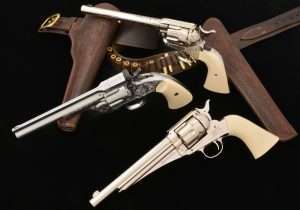
Colt built more Peacemakers between 1873 and 1879 than all the Remington Model 1875, 1888, and 1890 Single Actions combined. Even the S&W Schofield and all of the Model No. 3 Americans, Russians, and New Model No. 3 Single Actions produced from 1872 to 1912 take a far backseat to the Peacemaker for production. However, it was the 1875 Remington that maintained the company’s presence in the large caliber single action revolver market throughout the 1870s and 1880s. It seems only just that of the three CO2 powered Western revolvers available today that the 1875 Remington should be among them. Even coming in third in the Old West, when there were many choices and not too much money to be spent on a pistol, says something about the prestige of carrying a Remington. It was tough to beat Colt’s “Old Reliable” when deciding on the purchase of a new gun. You can say the same thing today of the Peacemaker, Schofield and Model 1875 Remington, when choosing among these three excellent CO2 BB and pellet cartridge-firing revolvers.
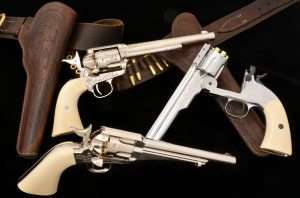
Inch for Inch, Ounce for Ounce
The 7-1/2 inch Umarex Colt Peacemaker has a rifled barrel and shoots only pellets. The Schofield and 1875 Remington have smoothbore barrels, 7.0 inches for the Schofield and 7-1/4 inches for the 1875 Remington, with internal barrel lengths of 6.75 inches for the Peacemaker (measured from the front of the cylinder to the recessed 4.5mm muzzle), 6-1/2 inches for the Schofield, and 6-3/4 inches for the 1875 Remington. Both the Schofield and Remington can shoot either BB or pellet cartridges (although as of this writing the pellet cartridges for the Schofield are not available). The 1875 Remington comes with six of each, which are marked on the rims for BBs and pellets, the latter with a pellet symbol. Unfortunately, just as it was in the Old West, the cartridges for the Schofield and Colt are incompatible, and in the case of the CO2 models, the 1875 BB and pellet rounds are also unique to the gun, so there is no interchangeability between these three revolvers. I know the 1875 Remington and Colt Peacemaker pellet shells look the same (except for the Colt’s being silver in color), but upon closer inspection you will see that the rim thicknesses are different on all three cartridges. History repeats itself.
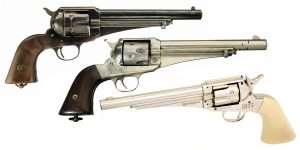
For quick handling almost nothing can rival a Colt Single Action, particularly in the CO2 lineup. The Peacemaker has a hammer draw of 4 pounds, 8 ounces average, and an almost hairpin 2 pound, 8 ounce, average trigger pull. The Schofield counters with a short, light hammer draw of 3 pounds, 13 ounces, and a light 3 pound, 5 ounce, average trigger pull. As to which is faster clearing leather, it’s all a matter of skills and preferences. As for the 1875 Remington, average hammer draw measured 4 pounds, 11.5 ounces, and trigger pull 3 pounds, 12.5 ounces, putting it almost dead square between the Peacemaker and Schofield. That’s the technical side, but when it comes to skinning that smokewagon, the Schofield is harder to handle and one would be hard pressed to separate the 7-1/2 inch Colt and 7-1/4 inch Remington when it comes to speed. While a gun is only as fast as the person using it, most folks would take their oath on the Colt.
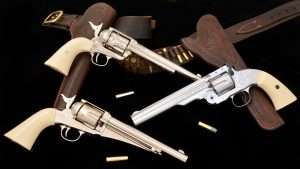
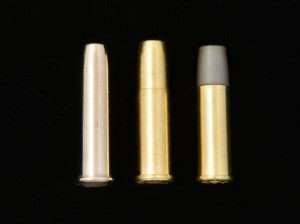
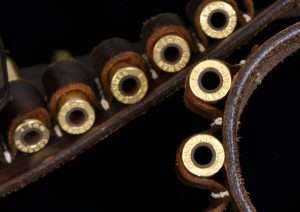
Next is the comparative weight and overall length of each gun. The alloy Peacemaker tips the scales at 34 ounces, the Schofield at 36.5 ounces and the 1875 Remington at 35 ounces, again right in the middle. If we were to compare the cartridge models, the weight of a 7-1/2 inch Peacemaker averaged 36 ounces, a Schofield around 44 ounces, and a Remington an average of 42 ounces (with comparable barrel lengths). Considering that the airguns are all-alloy construction, they are well within the ballpark, but the Colt hits the home run for being closest to the actual weight. Overall length of all three is within less than an inch of the cartridge guns.
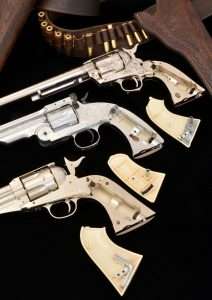
What’s in Your Holster?
We are faced with the same decision between three excellent American handguns that the U.S. Cavalry had to make in the 1870s. They ultimately stayed with the Colt Single Action Army, but also purchased and issued thousands of S&Ws (No. 3 American and Schofield models) and 1875 Remingtons. Cowboys, lawmen, and outlaws made the same choices and Remington always finished a solid third.
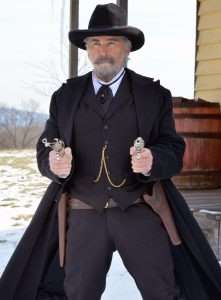
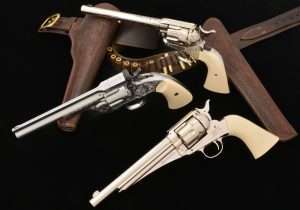
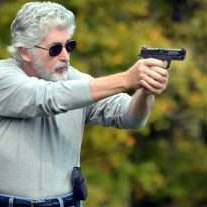
With the grips off the Remington has the least true to original profile . Overly flared like some of the cruder black powder replicas. The Schofield is the closest and the Colt , longer , to fit the co2, but still maintains the classic profile . I would suggest to Crosman that they taper the grip frame and modify the grips .Making a small removable co2 piercing tool is begging for it to be lost, and it is more difficult to use . So far on those characteristics, advantage to Schofield and Colt . Both my Schofield and Colts are deadly accurate . The Remington is the underdog in the competition.
As stated , for ammunition comparability, the Schofield is shut out again . The Colt and Remington may be compatible. I have the Dan Wesson pellet cartridges from the 715 . They fit and cycle in an Umarex Peacemaker . Interesting that the Umarexcartridges will not work in theDan Wesson . In the shooting test you could try the Peacemaker cartridges in the Remington and the Crosman Remington cartridges in both . For a brace of Remington / Colt pellet revolvers may be able to get by with Crosman cartridges . Not having the Remington I couldn’t check to see if the Colt cartridges worked in it . Should be a fun shootout , especially if it warms up!
TheCrosmans are the same as thenewerDanWessons so if you already have extra shells for the Dan Wesson 715 ,at least you can go well heeled with the Remington
What about the sights, is there an appreciable difference in the three? I realize the sights are fairly basic, but would you choose one over the other based only on the sights?
Thank you Mr. Adler as I only have the umarex colt I was curious. Also are the cylinders removable on the original Remington’s, and if so are they on the air guns? I really enjoy your concise writing style, and historical information, as a new reader I will be looking for your books.
As the saying goes, Colt Single Action Army , often imitated , never equaled. I believe the Remington had a slightly shorter cylinder than the Colt SAA. Not sure if that is the same on the Crosman version.
Remember reading somewhere that the Uberti cylinders on the 1875 replicas won’t accept some 45 Colt 250 gr loads that will fit in the Colt SAA cylinder due to the shorter cylinder by a couple of 1000th of an inch . Looking at the airgun cartridges they appear to be very close in length . Will see what happens on the open range tomorrow.
One advantage the Remington has , that is without the integral wrench in the grips , it will be easier to make aftermarket grips. Black Remington hard rubber , and plain wood to start.